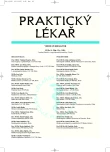Symptomatic diabetic neuropathy: irreversible nerve damage?
Klinicky manifestní diabetická neuropatie: nezvratné poškození nervu?
Diabetická periferní neuropatie je nejčastější pozdní komplikací diabetu s klinicky významnými projevy typu bolestí a poruch čití, s možností vzniku defektů a potřeby amputací na dolních končetinách. Ve svém přirozeném průběhu přechází od iniciálních funkčních změn až k pozdním, obtížně reverzibilním strukturálním změnám nervu. V patogeneze diabetické neuropatie se uplatňují vzájemně související metabolické a vaskulární mechanismy, které se vesměs odvíjejí od dlouhodobé hyperglykémie. Na tyto hypotetické mechanismy byla v minulosti zaměřena celá řada experimentálních a klinických studií, ve kterých byly v prevenci a léčbě diabetické neuropatie mj. testovány účinky navození dlouhodobé normoglykémie pomocí transplantace pankreatu nebo Langerhansových ostrůvků, blokáda polyolové cesty metabolismu glukózy inhibitory aldózo-reduktázy, ovlivnění oxidačního stresu nebo poruch v metabolismu esenciálních mastných kyselin či korekce deficitu růstových faktorů. Přes některé nadějné experimentální výsledky se dosud žádný léčebný postup zaměřený na patogenetické mechanismy neuplatnil v široké klinické praxi. Základním přístupem proto zůstává důsledná prevence vzniku ireverzibilního stadia diabetická neuropatie pomocí udržování optimální metabolické kompenzace již od doby zjištění diabetu.
Klíčová slova:
diabetická neuropatie; patogeneze; experimentální a klinické studie terapie.
Authors:
P. Bouček
Authors‘ workplace:
Ředitel: MUDr. Štefan Vítko, CSc.
; Institut klinické a experimentální medicíny, Praha
; Přednosta: Doc. MUDr. František SAUDEK, DrSc.
; Klinika diabetologie
; Přednosta: prof. MUDr. Terezie Pelikánová, DrSc.
; Centrum diabetologie
Published in:
Prakt. Lék. 2007; 87(2): 82-85
Category:
Various Specialization
Overview
Diabetic peripheral neuropathy is the most common late complication of diabetes mellitus which frequently results in clinically significant morbidities e.g. pain, sensory deficits, foot ulcers and amputations. During its natural course it progresses from initial functional to late poorly reversible structural changes. Various interconnected pathogenetic concepts of diabetic neuropathy based on metabolic and vascular factors mostly derived from long-term hyperglycemia have been proposed. These pathogenetic mechanisms have been targeted in several experimental and clinical trials which, for example. tested restoration of normoglycemia by pancreas or islet transplantation, polyol pathway blockade by aldose reductase inhibitors, mitigation of oxidative stress and correction of abnormalities in essential fatty acid metabolism or of growth factor deficits. Unfortunately, so far no treatment based on pathogenic considerations has been introduced into clinical practice and thus optimal glycemic control aimed at preventing the occurrence of irreversible structural nerve changes should be instituted immediately at the time of diagnosis of diabetes.
Key words:
diabetic neuropathy; pathogenesis; experimental and clinical studies of therapy.
Labels
General practitioner for children and adolescents General practitioner for adultsArticle was published in
General Practitioner

2007 Issue 2
- Hope Awakens with Early Diagnosis of Parkinson's Disease Based on Skin Odor
- Memantine Eases Daily Life for Patients and Caregivers
- Memantine in Dementia Therapy – Current Findings and Possible Future Applications
- Metamizole vs. Tramadol in Postoperative Analgesia
- Metamizole at a Glance and in Practice – Effective Non-Opioid Analgesic for All Ages
Most read in this issue
- Risk of malnutrition and nutritional support in Alzheimer disease
- Active search for prostate cancer by PSA testing in GP surgery
- The legacy of I. F. Semmelweis; key milestones in the development of hospital hygiene and current challenges.
- Symptomatic diabetic neuropathy: irreversible nerve damage?
